Wikipedia has a thorough and well research descriptions on the history of Singapore, click here.
I will only do a brief introduction here:
Temasek and Singapura
Prior to the name Singapura, Temasek (which means ‘Sea Town’ in Javanese) was the name of an early city on the site of modern Singapore. Now you know why there are so many institutions in Singapore named after Temasek. As for Singapura, legend has it that (or what we were taught in our primary school text books) when an Indonesian prince, Sang Nila Utama, set foot on this island in the 13th century, he saw a creature which he had mistaken for lion dashing in front of him and took this as an auspicious sign and founded a settlement called Singapura which means lion city. Funny that there were tigers ever sighted in the early days of Singapore but never a lion. Anyway the name stuck.
Raffles Stamford
Briton Sir Raffles Stamford from the British East India Company founded Singapore in 1819 and established Singapore as a trading post and settlement for the British Empire. Thanks to this great man, the influx of early immigrants from India, China and Arabs started and eventually settled here. Until 1824, Singapore was still a territory controlled by a Malay Sultan. It officially became a British colony on 2 August 1824. Many of the colonial buildings that were built in those era are still around e.g. the Parliament House, City Hall, Fort Canning just to name a few. Many institutions, schools, hospital,hotel,road,place have been named to remember the founder of Singapore.
I can’t help but to insert a hilarious take of Raffles’ YouTube clip here:
Japanese Occupation
Briefly between 1942 to 1945 during Second World War, the island was invaded and ruled by the Japanese. During the 3years and 8 months occupation, this place was renamed Syonan-to (昭南島 Shōnan-tō, “Light of the South Island” in Japanese). Many people especially the Chinese were killed due to their storng support to China who was under attacked by the Japanese imperial army.
After the surrender of the Japanese at the end of WW2, the British regained the ruling briefly followed by self governance. The prominent leaders in this period included David Marshall (who was a Jewish descendent) and Lim Yew Hock.
Independence
Under the leadership of Lee Kuan Yew, Singapore gained independence and was briefly part of Federation of Malaysia in 1963. The marriage however was marred with ideological differences and Singapore was subsequently kicked out of the federation in subsequent year by the federal government. Singapore gained its modern day independence on the 9 Aug 1965 as Republic of Singapore. The name Singapore was derived from the Malay word Singapura.
The Turbulant Years
The early days after independence was the most difficult years faced by the founding fathers of modern Singapore. Gansterism, communism and left wing ideologies were rampant, workers’ strikes were almost everyday’s affairs, massive unemployment caused by the British’s withdrawal of troops (Single largest employer then), confrontation with Indonesians etc made the survivability of Singapore highly questionable. However, with fine leadership, dedication and full commitment by the early PAP founding members, unwavering support and cooperation from the masses , a hardworking people and some luck, not only did the country survive but prosperous uninterrupted for the last 40 over years. A true miracle indeed!
Was Singapore a underdeveloped, mosquito-ridden swamp prior to Independence?
In 1968, Singapore’s per capita income was US$751, second only to Japan’s, which was US$1405. Indonesia’s per capita income for 1969 was US$80, Thailand’s US$65, South Korea’s $191, Taiwan’s US$304, Malaysia’s $326 and Hong Kong’s US$680. South Korea, Hong Kong and Taiwan experienced greater growth in per capita income than Singapore during the same period of time.
In 1961, Singapore had one of Asia’s most educated and literate populations, capable and hardworking. Dr Albert Winsemius, an industrial economist sent to Singapore by the UN praised Singapore’s workforce in his 1961 report to the Singapore government as ‘industrious, quick learners and a great asset for industrialization.’
The British has left Singapore with a good legal and infrastructure system at that time. Many of the historical colonial buildings that you current witness at the City Hall, Orchard Road and Raffles Place areas were built by the British. The city was the most important trading port in South East Asia at that time though the surrounding countries were going through a tubulant time due to the insurgence of the Communism ideology.
See a rare footage of an amatuer’s video uploaded by MichaelRogge, you will see the hustling and bustling of Singapore in the 1930s (click the direct link here if the embedded video broke). Worth mentioning is the streets and Singapore River seemed squeaky clean even by today’s standard. Updated 6 Jan 2014: The above-mentioned video seems to have been removed. So I am replacing it with another video showing the bustling Singapore in 1962. Note the Singapore River and Chinatown area were so much more vibrant than the dull but clean state of modern “Chinatown” which exist only in name.
See another rare footage uploaded by MichaleRogge titled: Old Singapore and Raffles hotel in 1961 and all old footages on Malaysia and Singapore.
related links:
Last updated Jun 2011


Leave a Reply